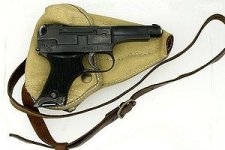Hi All!!! First time post. I am sure you all have seen this kind of post before, but I would appreciate any help you could give me.
My gun expertise is limited to enjoying shooting of a rifle in the woods at some homemade targets. My Daddy died awhile back and left this girl a Japanese pistol which I have no idea a. what to do with or b. how much it is worth. He has the certificates from the Army that authorized him to keep the side arm, the called it a carbine(??). It has the #s 30209 on the body of the gun and 12-0 at the top of the handle. On the opposite side of the gun are Japanese characters.
It comes with a heavy leather case. I can send pics to anyone if they are curious. I have a friend who was a sharpshooter in the US Marine Corp and he said it is empty, safe and complete.
Thanks all!
SWOJ
My gun expertise is limited to enjoying shooting of a rifle in the woods at some homemade targets. My Daddy died awhile back and left this girl a Japanese pistol which I have no idea a. what to do with or b. how much it is worth. He has the certificates from the Army that authorized him to keep the side arm, the called it a carbine(??). It has the #s 30209 on the body of the gun and 12-0 at the top of the handle. On the opposite side of the gun are Japanese characters.
It comes with a heavy leather case. I can send pics to anyone if they are curious. I have a friend who was a sharpshooter in the US Marine Corp and he said it is empty, safe and complete.
Thanks all!
SWOJ



